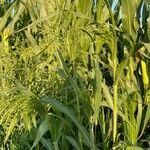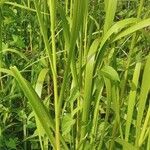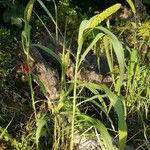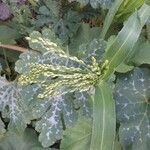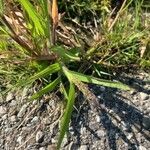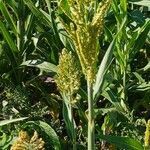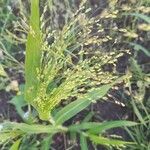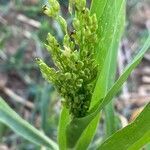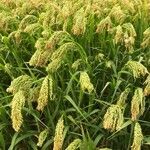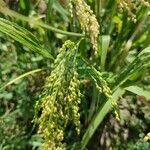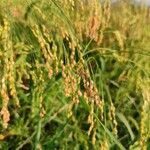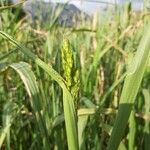Annual. Culms robust, 20–150 cm tall, glabrous or lower nodes and internodes pubescent or hispid. Leaves cauline; leaf sheaths hispid; leaf blades linear or narrowly lanceolate, 15–40 × 1–2.5 cm, glabrous to pilose or hispid, base cordate to amplexicaul, apex finely tapering; ligule 1.5–3 mm, a fringe of hairs from a membranous base. Panicle oblong to ovate in outline, 15–35 cm, drooping at maturity with the weight of the dense spikelets which are clustered toward the ends of the branches. Spikelets ovate to ovate-oblong, 4–5 mm, glabrous, acute to acuminate; lower glume ovate, 1/2–3/4 length of spikelet, 5-veined, acute or acuminate, separated by a short internode; upper glume equal to spikelet, 9–13-veined, acute or acuminate; lower floret barren, lemma similar to upper glume, palea reduced or absent; upper floret orange or yellow, smooth, shiny, usually persistent. Fl. and fr. Jul–Oct. 2n = 36, 40.
Stout annual 2–6(–10) dm; sheaths overlapping, densely hirsute; blades elongate, rounded at base, 10–20 mm wide; panicle included at base, pyramidal to cylindric, dense, 8–20 cm, often nodding at maturity; spikelets turgid, acute, 4.5–6 mm; first glume half as long, acute or acuminate, 5-veined; second glume and sterile lemma equal, distinctly 7-or 9-veined; fr stramineous to brown, 3–3.5 mm; 2n=36, 54, 72. Native of the Old World, occasionally cult. for forage and adventive along roadsides and in waste places. A wild-adapted type, widespread as a field-weed in the midwest (Wis., Minn., Ill., Io., N.D., S.D., Nebr., Kans., Colo.), has been named ssp. ruderale (Kit.) Tzvelev. It is larger, 7–20 dm, with open panicles 10–50 cm, and deciduous spikelets.
Loosely tufted annual 300-1200 mm tall. Leaf blade to 15-40 x 7-25 mm, expanded, loosely hairy or glabrous. Inflorescence 100-350 mm long, dense, often drooping; included or exserted from uppermost leaf; spikelets clustered in upper parts of branches. Spikelet 4-6 mm long, ovate to ovate-oblong, glabrous; glumes separated by internode; lower glume 1/2-3/4 as long as spikelet, 5-7-nerved, nerves prominent; upper glume 11-15-nerved; lower floret sterile, lemma 9-13-nerved, palea reduced; upper floret smooth or striate, glossy, white, yellow, red, brown or black when mature, persistent or deciduous.
An annual grass which grows up to 1 m high. It spreads to 15 cm across. It has a fibrous root system. The stalks are tufted. They are hairy at the base and on the nodes. The leaves are 30-50 cm long by 1-5 cm wide. They are narrow and flat. The edge is slightly rough with a few long hairs near the base. The seed head is much branched. The flower is yellow. The fruit is a grain. There are several races.
